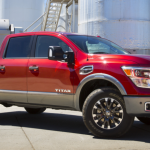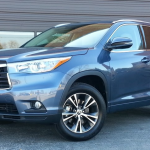
New cars cost a lot. The statement is based on more than anecdotal evidence. Based on the current rate of inflation, the average transaction price of a new vehicle will pass the $35,000 mark some time late this year or in early 2017—and for most folks, that’s a lot of bread.
According to the U.S. Government, the average household income (HHI) in America is about $53,000. It only takes a little calculator time to determine that the average new car costs 73 percent of the average family’s pre-tax income.
Now, let’s look back 40 years. It’s difficult to make a direct comparison between 1976 and 2016 incomes, because fewer households included two full-time wage earners back then. Per the U.S. Census folks, the average HHI in ’76 was $11,300. At the same time, the average automobile sold for around $4100. We go back to the ol’ calculator to learn that in 1976, a typical new car cost the average family just 36 percent of its yearly income.
So, what gives? Why are cars so expensive now? Of course there’s the vast collection of safety equipment that now comes standard on new vehicles. The 2016 Chevrolet Malibu we will discuss here, for example, comes standard with 10 airbags. This in addition to side-impact protection, rollover protection, antilock brakes, stability control, and a host of additional features designed—and now federally mandated—to help keep you and me alive.
Price of a 2013 Ford Pinto: $17,375
Also, emissions equipment costs money, as do more fuel efficient engines and transmissions. The 2016 Chevy Malibu comes standard with a 1.5-liter turbocharged engine. That new-for-2016 powerplant is very fuel efficient, but it is also more costly to build than the normally aspirated 2.5-liter engine it replaces—and that cost shows up on the bottom line.
The other thing driving up the cost of new vehicles is all the stuff we’ve come to expect on them. My father owned three cars on which the only options were AM radio and an automatic transmission. Such a vehicle would be virtually unsellable for a dealer today. Americans now expect all sorts of standard features and creature comforts on their new vehicles, and the base prices of said cars and trucks have risen accordingly.
Here, we’re going to examine the standard-equipment gap between a 1976 Chevrolet Malibu and a 2016 Malibu. It’s worth noting that the ’16 Malibu occupies essentially the same slot in Chevrolet’s model lineup as its predecessor did four decades ago, and that the Malibu is still a volume seller for Chevrolet.
Note that this comparison is being made between a base 1976 car and a 2016 “L” model. The L is something of a low-content fleet special, and does not come standard with the generally expected suite of mobile-phone connectivity equipment. The step-up LS model does include those features.
Test Drive: 2016 Chevrolet Malibu
| 1976 Malibu | 1976 Option Prices | 2016 Malibu L | |
| Base Price | $3,671 | $22,500 | |
| Length (in.) | 209 | 194 | |
| Width (in.) | 77 | 73 | |
| Wheelbase (in.) | 116 | 111 | |
| Curb weight (lbs.) | 3873 | 3086 | |
| Seating capacity | 6 | 5 | |
| Trunk space (cu. Ft.) | 15.3 | 15.8 | |
| Drivetrain | |||
| Engine | 250-inch six | 1.5-liter turbocharged 4 | |
| Horsepower | 105 | 163 | |
| Transmission | 3-speed manual | (3-speed auto, $260) | 6-speed automatic |
| Wheels and Tires | |||
| Wheels | Steel with caps | aluminum alloy | |
| Tires | 205/75-15 | 225/55-17 | |
| Exterior | |||
| Outside mirrors | manual LH | (“sport” mirrors, $27) | auto LH and RH |
| Cabin | |||
| Front seats | cloth/vinyl bench | cloth buckets | |
| Climate | heater | (air conditioning, $471) | air conditioning |
| Audio | opt. | (AM/FM stereo, $226) | 6-speaker AM/FM |
| Steering wheel | fixed | (Comfortilt steering, $52) | tilt/telescopic |
| Windows | manual | (power windows, $140) | power |
| Door locks | manual | (power locks, $89) | power |
| Clock | opt. | (electric clock, $19) | digital |
| Total options: $1284 |
Additionally, all of the 1976 Malibu options listed below are more or less standard on the current car:
| Power steering | $136 | |
| Cruise control | $73 | |
| Center console | $71 | |
| Power brakes | $58 | |
| Positraction (in the form of traction control) | $51 | |
| “Softray” tinted glass | $49 | |
| Instrumentation | $45 | |
| Rear-window defogger | $43 | |
| Auxiliary lighting | $35 | |
| Intermittent wipers | $28 | |
| Heavy-duty battery | $16 | |
| Floor mats | $15 | |
| Total options: |
$620 | |
The list of modern-day safety equipment for which there is no 1976 equivalent is extensive. Here are a few of the major items that are standard on the 2016 Malibu:
- 10 Airbags
- 4-wheel disc brakes with ABS
- Stability control
- Hill-start assist
- LATCH child-seat anchors
- OnStar telematics system
- Daytime-running lights (DRLs)
What does it all mean? Adjusting for inflation, the $3671 ‘76 Malibu would cost about $15,525 in 2016 dollars. That seems like a bargain, considering a new compact Chevrolet Cruze easily breaks the $20,000 barrier with only a modest helping of extra equipment. However, if we add in the $1904 worth of equipment that is missing from the base 1976 Malibu, the price rises to a hefty $5575, or—wait for it—$23,578 inflation adjusted. And, bear in mind, that price does not include any of the safety equipment listed above. That’s about $1000 more than our base 2016 model. I would argue that cars have not grown more expensive on a content basis, they have simply become much better equipped—perhaps TOO well equipped for some penny-pinching shoppers. All that said, the L model will likely represent less than ten percent of the 2016 Chevy Malibu’s production volume, with mid-level 2LT models taking the lion’s share of sales. For the record, 2LT models start at about $30,000.
Sure, rules and regulations have inflated the prices of new cars, but the buying public’s appetite for leather seats, premium audio systems, large alloy wheels, navigation systems, sunroofs, power seats, and high-grade cabin materials has had a similarly significant impact on transaction prices. Conclusion? New cars are actually a pretty good deal, assuming you place a value on all the stuff you’re getting as standard equipment. If not, there’s little you can do, because there’s really no such thing as a “stripper” anymore.



